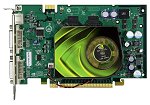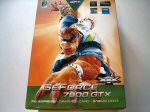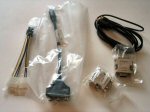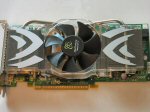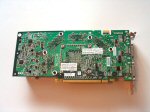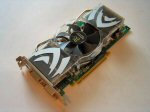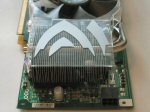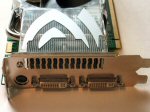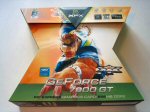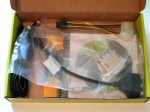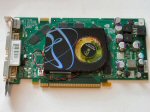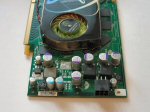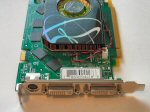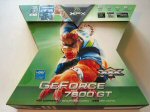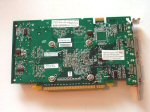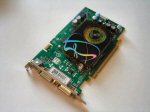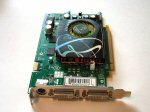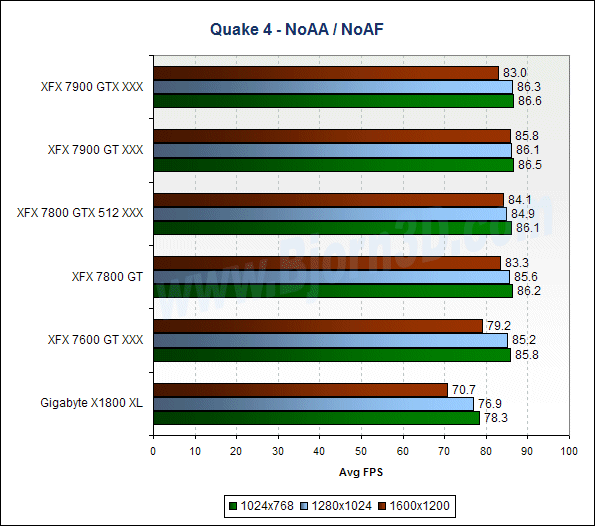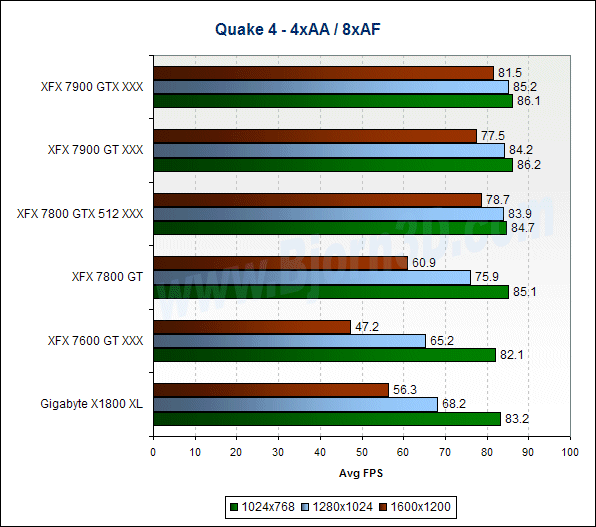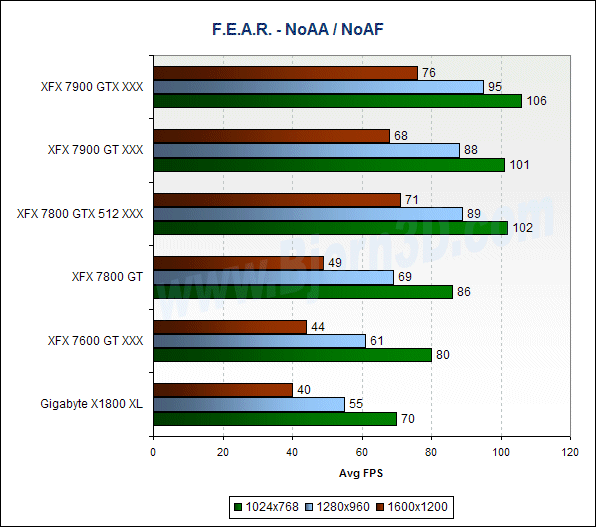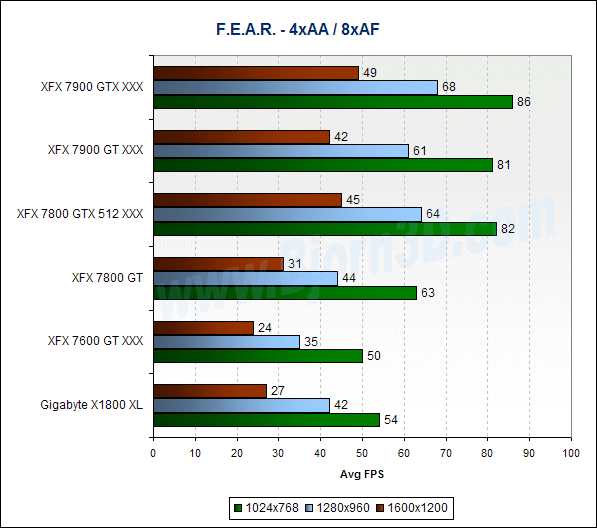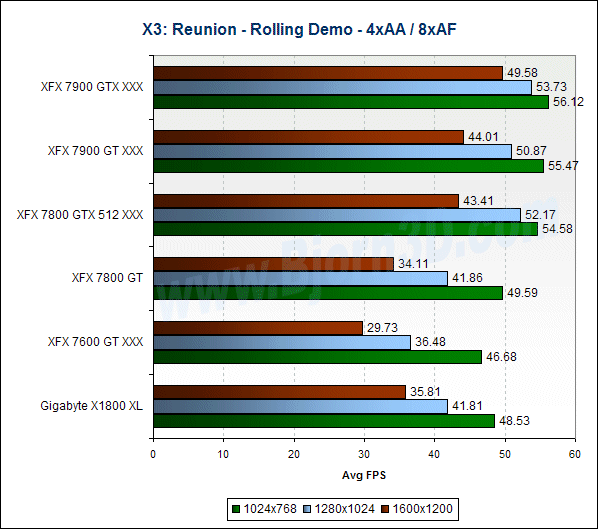Today is the day that NVIDIA finally fills the midrange gap in its GeForce 7 Series family of video cards. Additionally, a couple of new enthusiast level cards hit the market. We benchmark the XFX 7900 GTX XXX, 7900 GT XXX and 7600 GT XXX to see just how well NVIDIA’s new family members perform.
Introduction
Today is the day that NVIDIA finally fills in the gaps of the GeForce 7 Series. Well, there really was only one major gap – the midrange segment. In addition to filling that gap, NVIDIA is also attempting to maintain or regain (depending on how you look at it) graphics supremacy by upping the ante in the enthusiast and performance segments. The cards I’m referring to are the GeForce 7600 GT (midrange), 7900 GT (performance) and 7900 GTX (enthusiast). As is typical the last several quarters, this is another hard launch, and you should be able to find these cards available from NVIDIA’s system builder, add-in card, and e-tail partners today.
Although everyone would love to have the flagship cards, very few can actually afford them, which is why this launch is probably most exciting to the average Joe who is looking for a high bang for the buck level. The 7600 GT is designed to compete with the Radeon X1600 XT, and according to NVIDIA, the 7600 GT is one of their best products ever.
While NVIDIA is targetting the X1600 XT with the 7600 GT, the 7900 GT and 7900 GTX are aimed at ATI’s X1800 XL/GTO and X1900 XTX/XT, respectively. All three cards being launched today should come in at some pretty nice price points as well.
In support of this hard launch, we were fortunate enough to get our hands on one of each of the new cards from XFX. All three of the cards sport XFX’s “XXX Edition” label and are of course factory overclocked.
Features & Specifications
Features
The following features are shared across all three new cards.
- Full Microsoft® DirectX® 9.0 Shader Model 3.0 Support
- Built for Microsoft® Windows Vista™
- NVIDIA® SLI™ Technology
- NVIDIA® CineFX™ 4.0 Engine
- Full-Speed 128-Bit Studio-Precision Computation
- Transparency Antialiasing
- 90nm Process Technology
- NVIDIA PureVideo Features
- Adaptable Programmable Video Processor
- MPEG-2 Decode Acceleration
- H.264 Decode Acceleration
- WMV Decode Acceleration
- Inverse Telecine (3:2 & 2:2 Pulldown Correction)
- Bad Edit Correction
- Spatial-Temporal De-Interlacing
- High-Quality Scaling
- Video Color Correction
- Integrated SD and HD TV Output
- UltraShadow II Technology
- Normal Map Compression
- NVIDIA ForceWare® Unified Driver Architecture (UDA)
- OpenGL® 2.0 Optimizations and Support
- Dual Dual-link DVI Support
- Dual 400MHz RAMDACs
Specifications
| 7800 GTX | 7800 GTX 512 | 7900 GTX | 7900 GT | 7600 GT | |
| Bus Technology | PCI Express | PCI Express | PCI Express | PCI Express | PCI Express |
| Memory Interface | 256-bit | 256-bit | 256-bit | 256-bit | 128-bit |
| Memory | 256MB GDDR3 | 512MB GDDR3 | 512MB GDDR3 | 256MB GDDR3 | 256MB GDDR3 |
| Core Clock | 430 MHz | 550 MHz | 650 MHz | 450 MHz | 560 MHz |
| Memory Clock | 1.2 GHz | 1.7 GHz | 1.6 GHz | 1.32 GHz | 1.4 GHz |
| Pixels Pipes | 24 | 24 | 24 | 24 | 12 |
| Vertex Shaders | 8 | 8 | 8 | 8 | 5 |
While ATI decided to significantly boost the number of pixel shaders in its flagship cards (from 16 in the X1800 XT to 48 in the X1900s), NVIDIA chose a different route. The GeForce 7900 GT and 7900 GTX are based on the architecture of the 7800 GPU, but the 7900s are implemented in a 90nm process (recall that the 7800 GPU is based on a 110nm process). This means that the 7900 GTX is approximately one-half the die size of the X1900 XTX (196 sqmm vs 352 sqmm). NVIDIA claims to achieve better performance per watt while benefiting from less power consumption and lower heat generation than ATI’s high-end GPUs.
Llike the 7900s, the 7600 GT is based on the fundamental architecture of the 7800 GPU and is implemented in a 90nm manufacturing process. The 7600 GT’s die size is almost 20% smaller than the Radeon X1600 XT’s. NVIDIA claims to deliver better performance per watt with the 7600 GT when compared to the X1600 XT as well.
Closer Look – XFX 7900 GTX XXX
As with most of XFX’s latest offerings, the XFX 7900 GTX XXX Edition is factory overclocked. The core clock was bumped up 50MHz to 700MHz, and the memory clock was boosted from 800MHz (1.6GHz effective) to 900MHz (1.8GHz effective).
| Reference 7900 GTX | XFX 7900 GTX XXX | |
| Core Clock | 650 MHz | 700 MHz |
| Memory Clock | 1.6 GHz | 1.8 GHz |
| MSRP | $499.99 | $599.99 |
The XFX 7900 GTX XXX’s bundle consists only of practical accessories, manuals and a driver CD. No games or software are included, but I think most people are okay with that as long as it means a lower price when compared to similar cards with better bundles. Besides, if you can afford this card or two of them, you can probably afford all the games you want.
Here’s a list of the package contents:
- XFX 7900 GTX XXX Edition
- User’s Manual
- Quick Installation Guide
- Driver CD
- Molex-to-PCI Express Power Cable
- 2 x VGA/DVI Adapter
- S-Video Cable
- Component Video Out Cable
This card features 512MB of GDDR3 memory, 24 pixel pipes and 8 vertex shaders, which matches what the 7800 GTX 512 offers. Another thing it has in common with the GTX 512 is the cooler, a two-slot behemoth.
As with all high-end cards, the 7900 GTX must be hooked up to your system’s power supply. You can see the 6-pin power connector in the first image below. The 7900 GTX features two DVI connectors and an HDTV-out connector, which you can see in the second picture.
Just like the 7800 GTX 512, two of these in SLI will take up a lot of space in your system. Make sure you have the room on your motherboard before dropping your dough on two of these. Fortunately, most newer high-end motherboards have the PCI Express x16 slots spaced farther apart in order to accomodate cards like these.
Closer Look – XFX 7900 GT XXX
The 7900 GT is the little brother to the 7900 GTX. The 7900 GT differs in three important ways from the 7900 GTX: amount of memory, core clock speed and memory clock speed. While the GTX features 512MB of GDDR3, the GT sports 256MB of GDDR3.
| Reference 7900 GT | XFX 7900 GT XXX | |
| Core Clock | 450 MHz | 560 MHz |
| Memory Clock | 1.32 GHz | 1.65 GHz |
| MSRP | $299.99 | $349.99 |
You can see in the table above that the XFX 7900 GT XXX Edition boasts very nice overclocks: a 110MHz boost of the core and a 165MHz (330MHz) overclock for memory! All that and XFX’s industry-leading Double Lifetime Warranty. I’m betting this card will be in high demand right out of the gates.
The XFX 7900 GT XXX bundle is exactly the same as the 7900 GTX XXX’s bundle that I mentioned on the previous page. It’s simple and practical, and that’s about it. It also comes in XFX’s signature X-shaped box.
Here’s a list of the package contents:
- XFX 7900 GT XXX Edition
- User’s Manual
- Quick Installation Guide
- Driver CD
- Molex-to-PCI Express Power Cable
- 2 x VGA/DVI Adapter
- S-Video Cable
- Component Video Out Cable
Unlike the 7900 GTX, the 7900 GT is a single-slot solution and features a relatively modest copper cooler. Interestingly, the cooler only covers the GPU and only hovers over several of the memory chips. I like the black sticker that XFX customized the top of the cooler with. That and the bright yellow fan make for a decent looking card. It’s worth noting too that the 7900 GT is about three-fourths of an inch shorter than the 7800 GT.
All high-performance video cards require direct connection to the system PSU, and the 7900 GT is no exception. Like the 7900 GTX, the 7900 GT features dual DVI connectors and an HDTV-out connector.
With its physical size and pixel-pushing power, I think a couple 7900 GTs will find their way into many SLI systems over the coming months, especially if the street price is right.
Closer Look – XFX 7600 GT XXX
One of the most common differences between high-end cards and their midrange and low-end brothers is the memory interface. While the 7900s feature a 256-bit memory interface, the 7600 GT utilizes a 128-bit interface. Additionally, the 7600 GT features half the pixel pipes and three less vertex shaders than the 7900 cards. Now all that may sound like bad news, but rest assured that the 7600 GT looks to be a very capable card that should be very affordable. NVIDIA hopes the 7600 GT will dominate the midrange segment, where users are seeking the highest bang for their buck. XFX’s 7600 GT XXX Edition seems to be a good candidate for such domination with its 30MHz core overclock and 100MHz (200MHz) memory overclock.
| Reference 7600 GT | XFX 7600 GT XXX | |
| Core Clock | 560 MHz | 590 MHz |
| Memory Clock | 1.4 GHz | 1.6 GHz |
| MSRP | $199.99 | $219.99 |
The XFX 7600 GT XXX also comes in the X-shaped box, but its bundle is a little more exciting thanks the inclusion of a game, Starship Troopers. This version of the game was published late last year by Empire Interactive, but it has not received much positive praise unfortunately. Still, it might be worth a try at least, and it does liven up the bundle.
Here’s a list of the package contents:
- XFX 7600 GT XXX Edition
- User’s Manual
- Quick Installation Guide
- Driver CD
- Starship Troopers (DVD full version)
- 2 x VGA/DVI Adapter
- S-Video Cable
- Component Video Out Cable
The 7600 GT is a relatively small card. It features 256MB of GDDR3, 12 pixel pipelines and 5 vertex shaders. Moreover, the card appears to be cooled by the same heatsink and fan that is used on the 7900 GT. The fan seemed to get a bit louder with the 7600 GT than with the 7900 GT, though, especially during system start-up and once the card was under load.
Users shopping for this card will be happy to see that it does not require a direct connection to the system’s power supply. The dual DVI and HDTV-out connectors also find their way to this card. Note that this card is also SLI ready.
Test System & Benchmarks
We did not receive two of any of the cards, so we won’t be able to show you SLI performance yet. Also, the highest level ATI card we had on hand and in the same place as the new cards was an X1800 XL. NVIDIA claims to outperform ATI in each market segment with this launch, and we are working on getting the appropriate cards to verify this claim. As always, we suggest you check out as many articles as possible to get the clearest picture before making a purchase.
For reference, we are also including benchmark results from the XFX 7800 GTX 512 XXX and XFX 7800 GT. The former is NVIDIA’s previous flagship card and is being replaced by the 7900 GTX while the latter is being replaced by the 7900 GT. This should give you a good idea of where the new cards stand amongst NVIDIA’s previous high-end cards.
Test System
- DFI LANParty NF4 SLI-DR Motherboard (review)
- AMD Athlon 64 3800+
- Corsair TWINX1024-3200XL (review)
- Maxtor 120GB Serial ATA 7200RPM Hard Drive
- Video Card 1: XFX GeForce 7900 GTX XXX Edition – ForceWare 84.17
- Video Card 2: XFX GeForce 7900 GT XXX Edition – ForceWare 84.17
- Video Card 3: XFX GeForce 7600 GT XXX Edition – ForceWare 84.17
- Video Card 4: XFX GeForce 7800 GTX 512 XXX Edition (review) – ForceWare 84.17
- Video Card 5: XFX GeForce 7800 GT (review) – ForceWare 84.17
- Video Card 6: Gigabyte Radeon X1800 XL (review) – Catalyst 6.1
- Windows XP with Service Pack 2 and DirectX 9.0c
Benchmarks
- 3DMark06 – default settings
- Counter-Strike: Source, Video Stress Test – 4xAA / 8xAF
- Quake 4 v1.1 – NoAA / NoAF and 4xAA / 8xAF
- F.E.A.R. v1.03 – NoAA / NoAF and 4xAA / 8xAF
- X3: Reunion, Rolling Demo – NoAA / NoAF and 4xAA / 8xAF
Benchmark Results – 3DMark06
As usual, we’ll start things off with 3DMark. Here are the results from 3DMark06 with default settings and the detailed results from the feature tests.
Benchmark Results – CS: Source
The Counter-Strike: Source video stress test, which can be found in the CS: Source game menu, is a quick benchmark that tests a card’s ability to render various scenes that demonstrate the Source engine’s advanced capabilities. The average FPS is shown on the graph.
The performance of all three new cards is excellent, but we think the 7900 GT XXX and 7600 GT XXX are shaping up to be great cards. Look how well the 7900 GT does against the 7800 GTX 512, and check out the 7600 GT’s scores compared to the 7800 GT and X1800 XL. Let’s see if that continues.
Benchmark Results – Quake 4
Before benchmarking Quake 4, we updated it to v1.1. We used the latest version of the HardwareOC benchmark utility and the included HOC demo to benchmark the game. In the charts below, you will find the average FPS reported.
The 7900 GT and 7600 GT continue to show very intriguing performance. The 7900 GTX is right where we expected it to be (on top), but we didn’t know quite what to expect from the 7900 GT and 7600 GT. They definitely aren’t disappointing so far.
Benchmark Results – F.E.A.R.
F.E.A.R. is a game known for nice graphics, and it happens to be a good test of a powerful machine if you turn up all the eye candy. When running the performance test, I set all settings in the game to maximum, but I left soft shadows disabled.
Benchmark Results – X3: Reunion
To test X3: Reunion, I simply used the rolling demo that can be found at EGOSOFT’s web site. The demo includes a benchmarking feature that is very similar to the X2: The Threat rolling demo that we used to use. Various game scenes are rendered and then an average FPS is reported. All options were set to high and “Glow” was enabled for all runs.
Power Requirements
Before wrapping things up, we thought we’d give you an easy way to check out how much power NVIDIA recommends for both single and SLI operation of the three new cards being introduced today. Below, you will find a table listing the minimum recommended power supply ratings.
| Single Card | Two Cards in SLI | |
| 7900 GTX | 450W w/ 12V @ 22A | 550W w/ 12V @ 30A |
| 7900 GT | 350W w/ 12V @ 20A | 450W w/ 12V @ 26A |
| 7600 GT | 350W | 450W w/ 12V @ 22A |
Final Thoughts
A lot of gamers will be relieved to finally see top to bottom market coverage by NVIDIA’s 7 Series. We know a lot of you were really waiting on a midrange 7 Series card, and hopefully, the 7600 GT proved to be worth the wait to most of you. We think it’s a great card and are quite impressed by its performance. XFX’s 7600 GT XXX will definitely get recommended by us to gamers who need a solid gaming solution for around $200.
We really hope the 7900 GT stays around the $300 MSRP. We have our doubts that it will since it’s such a great card, but we’re keeping our fingers crossed, and we’ll update this article with street pricing information as soon as we get the chance. At an MSRP of about $350, XFX’s 7900 GT XXX is an excellent choice for anyone wanting a kickass card with considerably more future-proofing than the midrange cards provide. If you can afford it, you won’t regret it. There were rumors that this card would perform simliar to a 7800 GTX 512, and we were skeptical about those rumors. Turns out they were spot on. Color us impressed and then some.
That leaves us with the 7900 GTX, another solid flagship card from NVIDIA. We can’t wait to actually compare it (and the other cards) to a Radeon X1900. This two-slot beast offers all the bragging rights you could ever want, especially if you can afford dual or the new Quad SLI ( That would require a mother/daughter card, not 4 GTX cards) and the really expensive monitor you need to go with it. The MSRP for a vanilla 7900 GTX is $499. XFX’s 7900 GTX XXX’s MSRP is $100 more. Whether the factory overclock and Double Lifetime Warranty are worth the extra money or not is up to you. We’ll have to wait and see how overclockable the average 7900 GTX is before we draw any conclusions.
Availability is always a key factor for a launch and the weeks following. As long as these cards are readily available to consumers, we believe they will all be quite successful and deservingly so, especially the 7900 GT and 7600 GT. While the 7900 GTX is a very exciting and powerful card, the 7900 GT and 7600 GT really wowed us and captured most of our excitement for this launch. XFX’s offerings are all quite excellent and should be on your list if you are shopping for any of these cards today or in the future.
Extreme High Definition (XHD) gaming seems to be one of the next big things on the horizon, and NVIDIA has hit three performance levels and price points for XHD gaming very competently with today’s launch. Stay tuned for more information on these cards, their performance, XHD gaming, and everything else geeks love. And don’t forget to check out our forums – we have monthly giveaways!
 Bjorn3D.com Bjorn3d.com – Satisfying Your Daily Tech Cravings Since 1996
Bjorn3D.com Bjorn3d.com – Satisfying Your Daily Tech Cravings Since 1996
